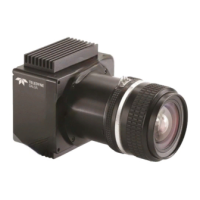36 Piranha 2 User’s Manual
03-032-00493-14 Teledyne DALSA
For FPN (dark light) the value of all pixels must be between 1DN and 127DN. For PRNU
(white light) the value must be between 128DN and 254DN. Use the gl command to
ensure the proper input to the digital processing, V
input
.
White light calibration will gain up to maximum white light pixel plus the maximum
FPN subtract pixel.
When performing any camera calibration, random noise is minimized by averaging out
up to 64 lines of valid data. To adjust the sample line size, use the css i command,
where i is 16, 32, 64 (factory setting). A low er value red u ces the cam era’s calibration time,
at the expense of increased coefficient error.
LED blinks green while calibrating. IMPORTANT: While camera is blinking green,
do not power down camera or memory may be corrupted.
Calibration Steps Overview
1. Change camera video mode to calibrated using the command svm 1
2. Set up the camera operating environment (i.e. line rate, exposure, gain, etc.)
3. Make sure there are suitable calibration targets. The target to calibrate should be a flat
field, e.g. plastic or ceramic for white calibration.
4. Set the calibration sample size using the command css (see Returning Multiple
Lines of Video page 30).
5. Perform Dark (FPN) calibration (see Dark Calibration on page 36).
6. Perform White (PRNU) calibration (see White Light Calibration on page 37).
7. Save settings and pixel coefficients using the commands wus and wpc.
Note: It is important to do the FPN calibration first. Results of the FPN calibration are
used in the PRNU procedure. We recommend that you repeat the calibration when a
temperature change greater than 10°C occurs.
Dark Calibration
Dark calibration is used to remove the fixed analog offset from the video path. It is
recommended you repeat the calibration when a temperature change greater than 10°C
occurs.
All manuals and user guides at all-guides.com
all-guides.com

